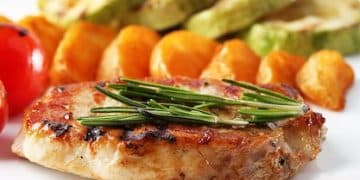7-Day High-Protein Meal Plan for Muscle Growth: 2025 Update

Achieving significant muscle growth requires a meticulously structured diet, and this article presents The Ultimate 7-Day High-Protein Meal Plan for Muscle Growth: Updated for 2025, meticulously designed to optimize protein intake, fuel workouts, and accelerate recovery.
Embarking on a journey to build muscle requires more than just dedicated gym sessions; it demands a strategic approach to nutrition. Your plate is as crucial as your weights, and that’s where The Ultimate 7-Day High-Protein Meal Plan for Muscle Growth: Updated for 2025 comes into play, offering a blueprint for fueling your body effectively.
Understanding the Pillars of Muscle Growth Nutrition
Before diving into specific meals, it’s essential to understand the foundational principles that underpin any effective muscle-building diet. Simply consuming large amounts of protein isn’t enough; the timing, quality, and balance with other macronutrients play equally vital roles. This section will break down the crucial components, ensuring you grasp the ‘why’ behind the meal plan. We’ll explore the synergistic relationship between protein, carbohydrates, and healthy fats, and how each contributes to your muscular development.
The Primacy of Protein
Protein is unequivocally the cornerstone of muscle growth. It provides the amino acids necessary for muscle repair and synthesis, especially after intense training. However, not all proteins are created equal. Focus on lean sources and ensure a consistent intake throughout the day to maintain a positive nitrogen balance, essential for an anabolic state.
- Complete Proteins: Prioritize sources like lean meats, poultry, fish, eggs, and dairy, which contain all essential amino acids.
- Plant-Based Alternatives: For vegetarians and vegans, combine plant proteins like legumes, quinoa, and nuts to achieve a complete amino acid profile.
- Timing is Key: Distribute protein intake across all your meals, including snacks, to optimize muscle protein synthesis.
Carbohydrates: Fuel for Performance and Recovery
Often misunderstood, carbohydrates are crucial for muscle growth. They provide the primary energy source for your workouts, sparing protein for its muscle-building functions. Post-workout, carbs replenish glycogen stores, accelerating recovery and reducing muscle breakdown.
Opt for complex carbohydrates that offer sustained energy release and are rich in fiber. These include whole grains, fruits, and vegetables. Simple sugars should generally be limited, unless used strategically post-workout to quickly replenish glycogen.
Healthy Fats: Essential for Hormonal Balance
Dietary fats often get a bad rap, but healthy fats are indispensable for overall health and muscle growth. They play a significant role in hormone production, including testosterone, which is vital for muscle development. Fats also aid in nutrient absorption and provide a concentrated energy source.
Include sources like avocados, nuts, seeds, olive oil, and fatty fish in your diet. These provide essential fatty acids, such as omega-3s, which have anti-inflammatory properties and can support recovery.
By understanding these nutritional pillars, you’re better equipped to follow and adapt the meal plan. Remember, consistency in applying these principles is what truly drives results in muscle growth.
Crafting Your 7-Day High-Protein Meal Plan Philosophy
Developing an effective meal plan for muscle growth isn’t just about listing foods; it’s about creating a sustainable, enjoyable, and results-driven strategy. Our 7-day plan for 2025 is built on a philosophy that balances nutritional science with practical application, ensuring you not only hit your macros but also enjoy your meals and stick to the plan long-term. This section outlines the thought process and key considerations that went into designing each day’s menu, reflecting a holistic approach to fitness and nutrition.

Macro-Nutrient Balance and Caloric Intake
The foundation of this plan revolves around an optimal macronutrient ratio tailored for muscle synthesis. While individual needs vary, a general guideline often includes 30-35% protein, 40-50% carbohydrates, and 20-25% healthy fats. The caloric intake is set to support a lean bulk, providing enough energy for intense workouts and recovery without excessive fat gain.
We’ve structured the meals to distribute these macros evenly throughout the day, preventing energy crashes and optimizing nutrient absorption. This consistent feeding pattern helps maintain a steady supply of amino acids to your muscles.
Meal Timing and Frequency
The plan emphasizes frequent, smaller meals rather than three large ones. This approach has several benefits for muscle growth. It keeps your metabolism elevated, provides a continuous supply of nutrients, and helps manage hunger levels, reducing the likelihood of overeating or making poor food choices.
- Breakfast: A high-protein start to kickstart metabolism and muscle protein synthesis.
- Mid-morning Snack: Prevents hunger and keeps energy levels stable until lunch.
- Lunch: Balanced meal to refuel and provide sustainment for the afternoon.
- Pre-Workout Snack (Optional): Provides quick energy for training sessions.
- Post-Workout Meal: Crucial for immediate glycogen replenishment and muscle repair.
- Dinner: A substantial, protein-rich meal for overnight recovery.
- Evening Snack (Optional): Slow-digesting protein sources to support muscle repair during sleep.
Variety and Palatability
Adherence is paramount. A meal plan, no matter how scientifically sound, is useless if it’s too restrictive or unappealing. This 2025 update incorporates a wide variety of ingredients, flavors, and cooking methods to prevent palate fatigue. We emphasize whole, unprocessed foods and encourage culinary experimentation within the guidelines. This variety also ensures a broad spectrum of vitamins, minerals, and antioxidants, supporting overall health and making the journey toward muscle growth enjoyable.
By following this philosophy, the meal plan becomes more than just a diet; it transforms into a sustainable lifestyle that supports your muscle-building aspirations with both efficacy and enjoyment.
The 7-Day High-Protein Meal Plan: A Detailed Breakdown
Here, we present the core of our updated plan: a day-by-day blueprint designed to fuel your body efficiently for muscle growth and recovery. Each day is meticulously planned to provide optimal protein intake, balanced with complex carbohydrates and healthy fats, ensuring you meet your nutritional goals consistently. Remember, portion sizes should be adjusted based on your individual caloric needs, activity level, and body composition goals. This plan serves as a template; feel free to swap similar food items to maintain variety, always keeping the macronutrient balance in mind.
Day 1: Kickstarting Your Week
- Breakfast: Scrambled eggs (4 large) with spinach and whole-wheat toast (2 slices).
- Mid-morning Snack: Greek yogurt (1 cup) with a handful of berries.
- Lunch: Grilled chicken breast (6 oz) salad with mixed greens, cucumber, tomatoes, and olive oil vinaigrette.
- Pre-Workout: Banana and a small handful of almonds.
- Post-Workout: Protein shake (2 scoops whey protein) with water or almond milk.
- Dinner: Baked salmon (6 oz) with steamed asparagus and a sweet potato.
- Evening Snack: Cottage cheese (1 cup) with a sprinkle of chia seeds.
Day 2: Sustaining Momentum
Day two builds on the nutritional foundation, ensuring your body continues to receive a steady supply of muscle-building nutrients. The emphasis remains on lean proteins and complex carbohydrates to support energy levels throughout the day.
- Breakfast: Oatmeal (1 cup cooked) with 1 scoop protein powder mixed in, topped with walnuts.
- Mid-morning Snack: Hard-boiled eggs (2) and an apple.
- Lunch: Turkey and avocado wrap (whole-wheat tortilla) with lettuce and bell peppers.
- Pre-Workout: Rice cakes (2) with a thin layer of peanut butter.
- Post-Workout: Protein shake (2 scoops casein protein) with water.
- Dinner: Lean ground beef (6 oz) stir-fry with broccoli, carrots, and brown rice.
- Evening Snack: Edamame (1 cup).
Day 3: Focus on Variety and Fiber
Introducing new protein sources and a high fiber intake helps with satiety and digestive health. This day integrates a wider range of plant-based options to diversify your nutrient intake.
- Breakfast: Cottage cheese (1 cup) with sliced peaches and a sprinkle of flax seeds.
- Mid-morning Snack: Protein bar (low sugar, high protein).
- Lunch: Lentil soup (large bowl) with a side of whole-grain bread.
- Pre-Workout: Small serving of whole-grain pasta.
- Post-Workout: Tuna salad (5 oz can) on whole-wheat crackers.
- Dinner: Chicken and vegetable skewers (6 oz chicken) with quinoa.
- Evening Snack: Greek yogurt (1 cup).
Day 4: Mid-Week Power Up
Mid-week requires sustained energy and continued nutrient support. This day emphasizes nutrient-dense options to keep you feeling full and energized for your training.
- Breakfast: Protein pancakes (2-3) with a tablespoon of natural maple syrup.
- Mid-morning Snack: Handful of almonds and an orange.
- Lunch: Leftover chicken and quinoa from Day 3.
- Pre-Workout: Rice cakes (2) with a slice of lean ham.
- Post-Workout: Protein shake (2 scoops whey protein) with a banana.
- Dinner: Pork tenderloin (6 oz) with roasted Brussels sprouts and farro.
- Evening Snack: Beef jerky (small portion).
Day 5: Fueling for the Weekend Push
As the week winds down, maintaining high-quality protein and complex carb intake is crucial for recovery and preparing for the weekend. This day offers hearty options.
- Breakfast: Breakfast burrito: whole-wheat tortilla with scrambled eggs, black beans, and salsa.
- Mid-morning Snack: Hard-boiled eggs (2) and a pear.
- Lunch: Ground turkey chili (large bowl) with a side of corn tortillas.
- Pre-Workout: A small handful of pretzels.
- Post-Workout: Smoothie with protein powder, spinach, and fruit.
- Dinner: Shrimp stir-fry (6 oz shrimp) with mixed vegetables and brown rice.
- Evening Snack: Cottage cheese (1 cup).
Day 6: Weekend Recharge
Weekends often bring opportunities for slightly more relaxed, yet still mindful, eating. This day offers satisfying meals to help you recharge while keeping your muscle-building goals in sight.
- Breakfast: Protein smoothie with milk, protein powder, spinach, and a banana.
- Mid-morning Snack: A handful of mixed nuts.
- Lunch: Large chef’s salad with mixed greens, sliced chicken breast (4 oz), hard-boiled egg, and a light vinaigrette.
- Pre-Workout: Apple slices with almond butter.
- Post-Workout: Protein shake (2 scoops whey protein).
- Dinner: Grilled steak (6 oz) with baked potato and a large side salad.
- Evening Snack: Greek yogurt (1 cup) with a few berries.
Day 7: Preparation and Reflection
The final day of the plan focuses on consolidation and preparing for the week ahead. It’s also a good time to reflect on your adherence and make minor adjustments for the following week.
- Breakfast: Whole-wheat pancakes (2-3) with a side of cottage cheese (1/2 cup).
- Mid-morning Snack: Rice cakes (2) with natural peanut butter.
- Lunch: Leftover grilled steak and salad from Day 6.
- Pre-Workout: Few dates.
- Post-Workout: Protein shake (2 scoops casein protein).
- Dinner: Boneless, skinless chicken thighs (6 oz) baked with bell peppers and onions, served with couscous.
- Evening Snack: Small bowl of air-popped popcorn (unbuttered).
This detailed breakdown should provide a clear pathway to follow for a week of muscle-fueling nutrition. Remember to listen to your body, stay hydrated, and adjust portions as needed.
Key Considerations and Customization for Optimal Results
While the 7-day meal plan provides an excellent framework, true success in muscle growth is often found in the nuances of personalization and attention to detail. No two bodies are exactly alike, and what works perfectly for one individual might need slight adjustments for another. This section delves into the critical considerations that allow you to adapt the plan to your unique needs, maximizing its effectiveness for your specific goals and lifestyle.

Hydration: The Unsung Hero of Performance
Adequate hydration is frequently overlooked but plays an immense role in muscle function, nutrient transport, and overall performance. Dehydration, even mild, can significantly impair your workouts and recovery. Aim to drink at least 8-10 glasses of water per day, and even more if you’re engaging in intense physical activity or in a hot climate.
- Pre-workout: Hydrate well in the hours leading up to your training session.
- During workout: Sip water regularly to replace fluids lost through sweat.
- Post-workout: Continue hydrating to aid recovery and replenish fluid balance.
Don’t wait until you’re thirsty; make hydration a continuous effort throughout your day. Sometimes, what feels like hunger can simply be a craving for water.
Individualized Calorie and Macronutrient Adjustments
The provided meal plan is a general guideline. Your specific caloric and macronutrient needs will depend on various factors including your age, sex, current body weight, activity level, and specific goals (e.g., lean bulk vs. maintenance). It’s highly recommended to calculate your Total Daily Energy Expenditure (TDEE) and adjust the plan accordingly.
Tools like online calculators or consultations with a registered dietitian can help you determine precise numbers. Once you have your personalized targets, you can scale the portion sizes of the foods in the plan to meet those numbers without altering the nutritional balance substantially.
Supplements: Enhancing, Not Replacing
Dietary supplements can complement your meal plan, but they are never a substitute for whole, nutrient-dense foods. Their role is to fill nutritional gaps and potentially enhance performance or recovery. Common supplements for muscle growth include:
- Whey Protein: Excellent for post-workout recovery due to its fast absorption.
- Creatine Monohydrate: Proven to increase strength and power output.
- BCAAs (Branched-Chain Amino Acids): May help reduce muscle soreness and fatigue.
- Fish Oil: Provides Omega-3 fatty acids, beneficial for inflammation and overall health.
Always consult with a healthcare professional or a registered dietitian before starting any new supplement regimen to ensure it’s safe and appropriate for your individual needs. Remember, supplements are the “icing on the cake,” not the cake itself.
By integrating these key considerations, you transform a generic meal plan into a powerful, personalized tool for achieving your muscle growth aspirations. Consistent tracking and periodic adjustments will further optimize your results.
Common Pitfalls and How to Avoid Them
Embarking on a high-protein meal plan for muscle growth can be incredibly effective, but the path isn’t without its challenges. Many individuals encounter common pitfalls that can derail their progress, leading to frustration and slower results. Recognizing these hurdles in advance is the first step toward overcoming them. This section addresses the most frequent mistakes made in dietary planning for muscle gain and offers practical strategies to navigate them successfully, ensuring your journey is as smooth and productive as possible.
Undereating or Overeating
One of the most common mistakes is not consuming the right amount of calories. Undereating can lead to insufficient energy for workouts and hinder muscle protein synthesis, effectively stalling growth. Conversely, overeating, especially with calorie-dense but nutrient-poor foods, can lead to unwanted fat gain, making your muscle-building efforts less efficient. The key here is meticulous tracking and adjustment.
- Solution: Use a food tracking app to monitor your caloric and macronutrient intake for a few days. Compare this to your calculated TDEE and adjust portions in the meal plan accordingly. Be patient and make small, consistent changes. Your body’s needs can change over time, so regular re-evaluation is crucial.
Lack of Variety Leading to Nutrient Deficiencies and Boredom
Sticking to the same few meals day in and day out, even if they are nutritionally sound, can lead to boredom and potential micronutrient deficiencies. This often culminates in cravings, leading individuals to stray from their plan.
- Solution: Embrace variety within the meal plan’s structure. Explore different lean protein sources, complex carbohydrates, and a rainbow of fruits and vegetables. Experiment with herbs, spices, and healthy cooking methods to keep meals exciting. Rotating your food choices ensures a broader spectrum of vitamins, minerals, and phytonutrients.
Neglecting Hydration and Timing
As mentioned earlier, proper hydration is critical, yet often overlooked. Similarly, strategic meal timing plays a significant role in optimizing nutrient absorption and muscle recovery. Skipping post-workout meals, for instance, can impede your body’s ability to repair and rebuild muscle tissue efficiently.
- Solution: Make water intake a priority throughout the day, especially around workouts. Set reminders if necessary. Adhere to the recommended meal timings, particularly around your training sessions, to maximize nutrient delivery when your body needs it most. Prepare meals and snacks in advance to avoid last-minute scrambling.
By being aware of these common pitfalls and proactively implementing these solutions, you can significantly enhance your adherence to the meal plan and accelerate your progress toward achieving your muscle-building goals. Consistency, awareness, and flexibility are your best allies.
Cooking Tips and Meal Prep Strategies for Success
Adhering to a high-protein meal plan for muscle growth often hinges on effective meal preparation and smart cooking techniques. The reality of busy schedules means that spending hours in the kitchen every day isn’t feasible for most. This section provides invaluable tips and strategies to streamline your cooking process, make healthy eating more convenient, and ensure you consistently hit your nutritional targets without feeling overwhelmed. Practicality is key when it comes to long-term dietary success.
Efficient Meal Prepping for the Week
Meal prepping is the cornerstone of successful dietary adherence. Dedicating a few hours one day a week (typically Sunday) can save you immense time and decision-making during busy weekdays. The goal is to have nutritionally balanced meals readily available, minimizing the temptation of less healthy, convenient options.
- Batch Cook Proteins: Grill or bake large quantities of chicken breast, lean ground turkey, or fish. These can be stored and used in various meals throughout the week.
- Pre-Chop Vegetables: Wash, chop, and store vegetables like broccoli, bell peppers, and spinach in airtight containers. This makes assembly for salads, stir-fries, or side dishes much faster.
- Cook Grains in Bulk: Prepare a large batch of brown rice, quinoa, or oats. These carbohydrates serve as excellent bases for meals and can be easily portioned.
- Portion Control: Invest in good quality meal prep containers to portion out your meals. This removes guesswork and helps maintain caloric and macro accuracy.
Smart Cooking Techniques for Flavor and Health
Healthy eating doesn’t have to be bland. Utilizing smart cooking techniques not only enhances the flavor of your meals but also helps retain nutrients and keeps fat content in check. Focus on methods that require minimal added oils and bring out the natural flavors of ingredients.
- Grilling, Baking, and Steaming: These methods are excellent for cooking proteins and vegetables without excessive fat. Use marinades and spices to infuse flavor.
- Air Frying: A modern alternative for achieving crispy textures with significantly less oil than deep-frying. Great for chicken, fish, and vegetables.
- Slow Cooking/Instant Pot: Perfect for preparing tender meats like roasts or stews. These methods are largely hands-off and can produce multiple servings.
- Herb and Spice Blends: Ditch high-sodium seasonings or sugary sauces. Experiment with a wide range of herbs and spices to add depth and complexity to your dishes. Lemon juice, vinegars, and fresh garlic can also elevate flavors naturally.
By integrating these meal prep and cooking strategies into your routine, you’ll find that following The Ultimate 7-Day High-Protein Meal Plan for Muscle Growth: Updated for 2025 becomes a much more manageable and enjoyable part of your muscle-building journey. Consistency in preparation translates directly to consistency in results.
Tracking Progress and Adjusting Your Plan for Ongoing Gains
Building muscle is a dynamic process that demands continuous adaptation and meticulous tracking. A meal plan, no matter how well-designed, is only effective if it’s regularly evaluated and adjusted based on your body’s responses and evolving needs. This final section emphasizes the importance of monitoring your progress, understanding the signs your body sends, and making informed modifications to your plan to ensure sustained muscle growth and prevent plateaus. It’s about cultivating a responsive approach to your nutrition.
Monitoring Your Body’s Response
Your body is the best feedback mechanism. Pay close attention to how you feel, perform, and look as you follow the plan. Key indicators to track include:
- Energy Levels: Are you feeling consistently energetic throughout the day and during workouts, or are you experiencing crashes?
- Workout Performance: Is your strength increasing? Are you able to complete more reps or sets?
- Recovery: How quickly do you recover from workouts? Are you experiencing excessive soreness?
- Body Composition Changes: Regularly take measurements (waist, arms, chest, thighs) and progress photos. Don’t rely solely on the scale, as muscle gain can mask fat loss, or vice versa.
- Hunger and Satiety: Are you feeling overly hungry or uncomfortably full? This can indicate a need to adjust portion sizes.
Keep a journal or use an app to log these observations. This quantitative and qualitative data will be invaluable for making informed decisions.
The Art of Strategic Adjustments
Based on your progress tracking, you’ll need to make strategic adjustments to your meal plan. This isn’t about drastic overhauls but rather subtle tweaks that optimize your intake. For instance, if you’re hitting performance plateaus or not seeing the desired muscle growth, you might need to slightly increase your caloric intake, focusing on complex carbohydrates and lean proteins. If you’re gaining unwanted fat, a slight reduction in overall calories or a re-evaluation of fat intake might be necessary.
The key is to make one change at a time and then observe its effect for a couple of weeks before making another. This systematic approach allows you to pinpoint what works best for your unique physiology. Remember, consistency over time is what yields results. Even small, sustainable changes can lead to significant gains when applied diligently over weeks and months.
By actively tracking your progress and embracing the need for strategic adjustments, you transform The Ultimate 7-Day High-Protein Meal Plan for Muscle Growth: Updated for 2025 from a static guideline into a dynamic, personalized strategy that evolves with you, ensuring continuous improvement on your muscle-building journey.
| Key Aspect | Brief Description |
|---|---|
| 💪 Protein Focus | Emphasizes lean protein sources for muscle repair and growth, distributed throughout the day. |
| 🍚 Balanced Macros | Optimal balance of proteins, complex carbs, and healthy fats to fuel workouts and recovery. |
| ⏱️ Meal Timing | Frequent, smaller meals and strategic nutrient intake around workouts to optimize absorption. |
| ✅ Customization | Tips for personalizing the plan based on individual caloric needs, lifestyle, and progress tracking. |
Frequently Asked Questions About High-Protein Meal Plans
For optimal muscle growth, it’s generally recommended to consume between 0.7 to 1 gram of protein per pound of body weight per day. This intake helps ensure adequate amino acid delivery for muscle protein synthesis and repair, especially crucial after resistance training. Individual needs may vary based on activity level and intensity.
Absolutely! Plant-based athletes can achieve significant muscle growth by focusing on a diverse range of complete plant proteins. Sources like lentils, chickpeas, tofu, tempeh, quinoa, seitan, and combinations of grains and legumes provide all essential amino acids. Strategic planning and sometimes supplementation (e.g., B12) are key.
While the “anabolic window” isn’t as strict as once believed, consuming a combination of protein and carbohydrates within 1-2 hours post-workout is still beneficial. It aids in quickly replenishing glycogen stores and kickstarting muscle repair. However, if you’ve eaten recently before your workout, the urgency lessens slightly.
Carbohydrates are extremely important. They are your body’s primary energy source, fueling intense workouts and sparing protein for muscle repair. Post-workout carbs replenish muscle glycogen, crucial for recovery and reducing muscle breakdown. Choosing complex carbohydrates like whole grains, fruits, and vegetables is best.
Boredom is a common reason people abandon diets. To combat this, embrace variety! Swap out protein sources, try different vegetables, and experiment with various herbs and spices. The plan is a template; feel free to customize meals with similar macronutrient profiles to keep things exciting and sustainable long-term.
Final Thoughts on Your Muscle Growth Journey
Embarking on The Ultimate 7-Day High-Protein Meal Plan for Muscle Growth: Updated for 2025 is more than just following a menu; it’s adopting a strategic approach to fueling your body for optimal performance and development. This plan serves as a robust foundation, integrating scientific principles with practical, delicious meals. Remember that consistency, alongside intelligent adjustments based on your body’s unique response, will be your greatest allies in achieving sustained muscle growth. By prioritizing quality nutrition, diligent tracking, and smart preparation, you’re not just building muscle, you’re cultivating a healthier, stronger you.





